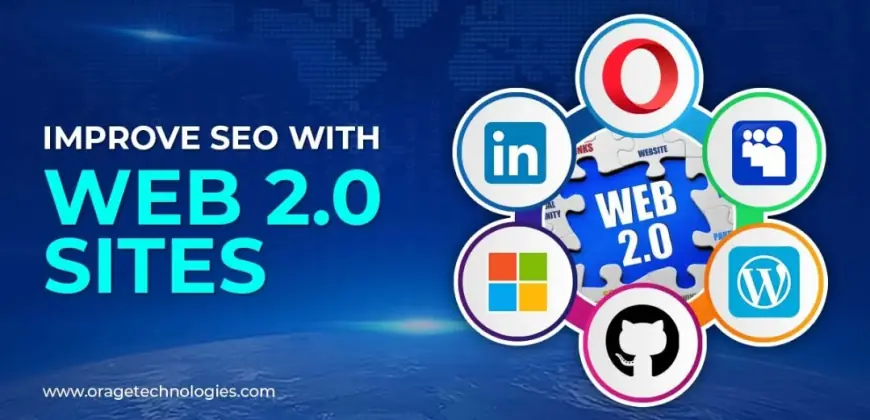What Are Web 2.0 Sites and How They Enhance Your SEO Strategy in 2025

In the constantly evolving world of digital marketing, search engine optimization (SEO) remains one of the most powerful ways to attract organic traffic. Businesses, bloggers, and marketers are always searching for innovative strategies to get ahead in search rankings. Among these strategies, Web 2.0 backlinks have stood the test of time. But before diving into how these platforms can boost your rankings, it's crucial to answer a foundational question: what are web 2.0 sites?
This article delves into what Web 2.0 sites are, how they work, why they are important for SEO, and how you can leverage more than 200+ Web 2.0 platforms to drive your site's visibility and authority.
Learning the Fundamentals: What Are Web 2.0 Sites?
Simply put, Web 2.0 websites are sites where users are free to create and post their own content. Web 2.0 websites differ from the old static websites (Web 1.0) in that they are user-driven, dynamic, and interactive. Web 2.0 sites provide users with opportunities to submit blogs, articles, images, videos, comments, among others.
When we inquire, what are web 2.0 sites, we're really talking about sites such as WordPress.com, Blogger, Tumblr, Medium, and Weebly—sites that provide free content creation and publication features without needing to know sophisticated technical skills.
The characteristic attributes of Web 2.0 sites are:
-
User-generated content
-
Simple, user-friendly interfaces
-
Multimedia support
-
Social sharing feature
-
Customizable page layouts
These sites are now at the heart of contemporary SEO due to the fact that they enable users to create content-rich microsites that can be backlinked to an authoritative domain, which enhances backlink profiles and domain authority.
Why Web 2.0 Sites Matter for SEO
Now that we’ve clarified what are web 2.0 sites, let’s look at why they matter in SEO. One of the primary ranking factors in Google’s algorithm is backlinks—specifically, high-quality links from authoritative domains. Web 2.0 sites provide a legitimate way to create these backlinks in a controlled environment.
Here's how Web 2.0 platforms help with SEO:
1. Authority Building
Web 2.0 websites tend to possess high domain authority. When you create content on these websites and link it back to your site, it passes some of that authority onto your domain.
2. Link Diversity
Search engines reward diverse backlink profiles. When you create links from multiple Web 2.0 domains, you are indicating to Google that your site is being referenced by a multitude of authoritative sources.
3. Content Syndication
These kinds of sites enable you to rewrite your blog posts or publish new content on secondary keywords. This increases your digital footprint and catches more search intent without causing duplicate content problems if done appropriately.
4. Indexing and Crawling
Web 2.0 sites are crawled often by search bots. Publishing on these sites ensures that your backlinks get indexed as fast as possible and aids in quicker rankings.
What Is the Use of Web 2.0 Sites in Digital Marketing?
Other than SEO, Web 2.0 websites are applied heavily in other aspects of online marketing. They are content centers, branding vehicles, and traffic generators. They are utilized by various businesses for:
-
Creating niche credibility
-
Publishing company news or product releases
-
Informing audiences
-
Initiating content marketing campaigns
-
Connecting with online communities
Whether your product is a personal blog, an affiliate product, or a small business, knowing what are web 2.0 sites are enables you to use them to your advantage in your overall digital marketing strategy.
Best Practices for Using Web 2.0 Sites for SEO
Having a few backlinks from Web 2.0 sites isn't going to launch you into orbit anytime soon. Google rewards quality and relevance. That's why using Web 2.0 SEO requires a strategic approach.
Here are best practices to abide by:
1. Utilize Unique, High-Quality Content
Do not copy and paste content between various Web 2.0 sites. Every site must have unique, value-based content that flows with your niche.
2. Brand Your Microsites
Include branding aspects like your logo, brand name, and consistent voice in your Web 2.0 blogs. This establishes credibility and trust with the users as well as the search engines.
3. Optimize On-Page SEO
Implement proper meta titles, descriptions, H1 tags, variations of keywords, and internal links into your Web 2.0 material. This will provide these microsites with a higher possibility of ranking independently too.
4. Anchor Text Variation
Don't over-optimize and use the same anchor text for all backlinks. Vary branded, generic, and long-tail keywords to keep the profile natural.
5. Sites Stay Active
Keep your Web 2.0 properties updated. Fresh sites are more likely to be indexed and trusted by search engines.
How to Build 200+ Web 2.0 Backlinks Without Getting in Trouble
You may ask: is it even worth building backlinks from more than 200 Web 2.0 sites?
Yes, but with caution and in moderation.
Begin Small
Start by posting on 5–10 high-authority sites. Watch their performance in search engines before expanding.
Develop a Posting Frequency
Drip-feed your Web 2.0 content weeks or months apart. A burst of backlinks can activate spam filters or make it go to manual review.
Blend Dofollow and Nofollow Links
Natural backlink profiles have a balanced mix of both. Most Web 2.0 sites provide nofollow links, but they still drive brand mentions and traffic.
Monitor Your Links
Use tools such as Google Search Console, Ahrefs, or SEMrush to monitor backlink indexing and watch for the effect on your domain authority and rankings.
What Are Web 2.0 Sites to Avoid?
All Web 2.0 websites are not equal. Some are low-quality, spam-filled, or abandoned. Utilizing such platforms can be more of a curse than a blessing.
Here's how to recognize bad platforms:
-
Thin or copied content rules the site
-
Too many ads or pop-ups
-
No active support or moderation
-
Long loading times for pages
-
Unrelated or irrelevant niche channels
When conducting research on what are web 2.0 sites, limit your research to high-traffic, trusted, and well-indexed websites only. Quality will always trumps quantity in SEO for the long term.
The Future of Web 2.0 in SEO
Others claim that Web 2.0 backlinks are obsolete. But this is a misperception about their function. While spambase linkbuilding strategies are penalized, quality Web 2.0 content still gains search engine trust if done appropriately.
As AI content arises and Google updates become more rigorous, Web 2.0 websites provide the only place to publish manually written and pertinent content that establishes both brand awareness and search relevance.
Besides, Web 2.0 sites are transforming into hybrid content + social sites that enable you to interact with the users while enhancing rankings.
Conclusion: What Are Web 2.0 Sites in 2025 and Why You Should Use Them
Thus, what are web 2.0 sites, and why should you care?
In brief, they are easy-to-use, high-authority content sites that aid in building backlinks, increasing domain authority, and overall SEO performance. When applied properly, they can be a sustainable and effective component of your link-building strategy.
Applying more than 200+ Web 2.0 websites doesn't equal making spam. It means selecting relevant sites carefully, producing value-packed content, and creating a long-term foundation for SEO success.
If ranking higher, driving more traffic, and gaining authority in your niche are what you're after, then it's time to add Web 2.0 sites to your digital marketing arsenal.
What's Your Reaction?
 Like
0
Like
0
 Dislike
0
Dislike
0
 Love
0
Love
0
 Funny
0
Funny
0
 Angry
0
Angry
0
 Sad
0
Sad
0
 Wow
0
Wow
0
















































